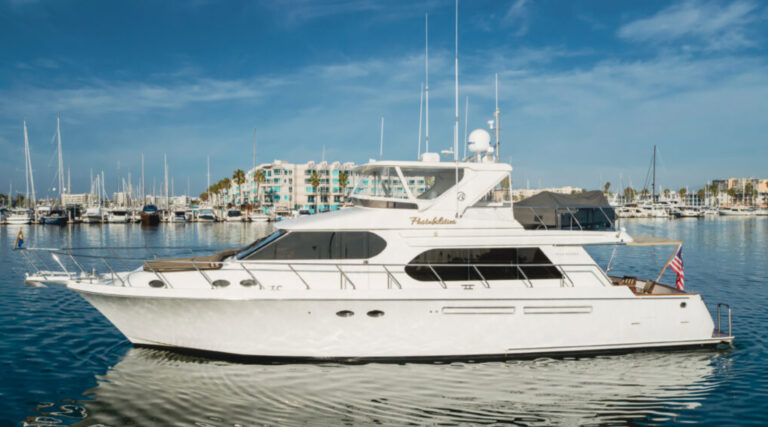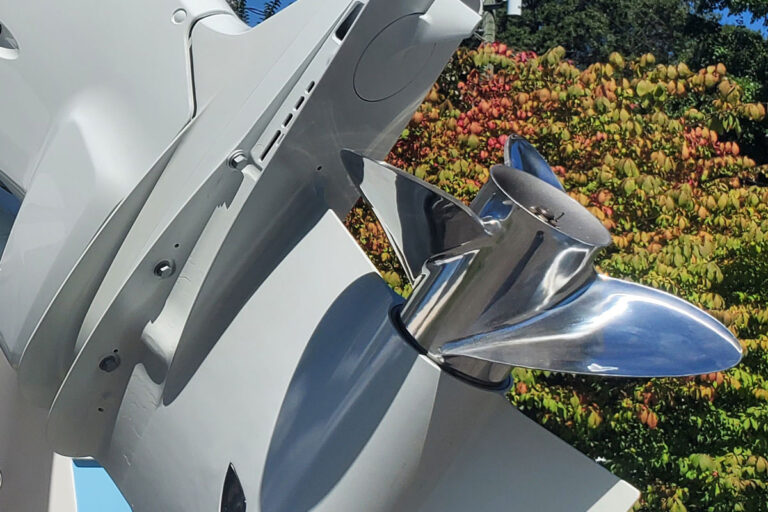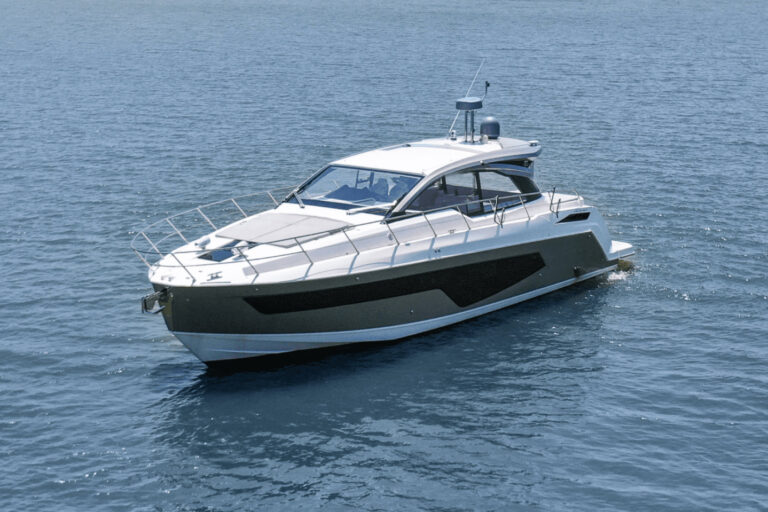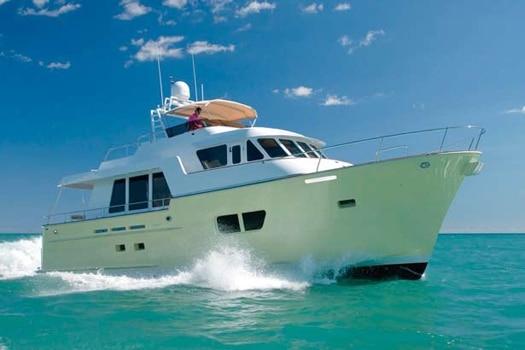
ytgjan09obkanter525.jpg
Rugged-looking passagemakers built of steel or aluminum have always captured my imagination with their “go-anywhere,” workboat style. They’re handsome, but not always beautiful. The all-aluminum Kanter 56, designed by Canadian naval architect Greg Marshall and built by Ontario’s highly respected Kanter Yachts, however, achieves a striking balance of robust toughness and elegant styling.
First and foremost, her experienced owner wanted his new yacht to meet the highest standards for safety at sea. He knew what it was like to get caught offshore in severe conditions with the wrong boat. “I was running my production 52-footer in very large, following seas, and she broached,” he said. “Maybe it was my fault, but she went over on her side and I didn’t think she was coming back. But she finally did. When I got home, I put her up for sale and began my search for a design with much greater stability.”
He discovered Marshall’s design, which adhered to ISO 12217 Category A standards, which state: “A boat considered to be designed to operate in winds of Beaufort 10 or less and the associated wave heights…” Since Beaufort 10 conditions call for winds of 48 to 55 knots and seas of 20 to 30 feet, Marshall’s design was definitely meant for serious cruising. As designed, the Kanter 56 is able to return quickly from a 90-degree knockdown.
The fact that it would be built of aluminum by the Kanter yard, which also builds search-and-rescue vessels for the Canadian Coast Guard, gave the owner the confidence his new yacht could handle the conditions in which he might once again find himself.
Kanter Yachts is a 30-year-old, family-owned and -operated business, and Manfred Kanter, Jr., runs the shop along with his brother, Chris. Manfred, Sr., continues to help steer the company on its successful course. When you buy a Kanter, you deal directly with the Kanters.
“You can’t put everything in a contract. They did a lot of things they didn’t have to, and it has exceeded my expectations,” said Sunshine’s owner, who found the building process to be as enjoyable as owning the finished yacht. He could not have been happier the day I met him onboard with Manfred, who was anxious to show me the yacht’s custom details.
I was first struck by the harmonious look created by her raised pilothouse, low-profile flying bridge, stepped sheerline and covered aft deck. She definitely avoids the skyscraper approach to interior volume. Sitting in her slip, she seemed to be asking to be untied and let loose. Even while stationary, her lines give her a graceful, forward motion.
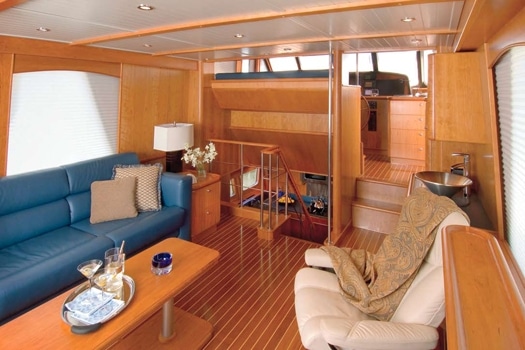
|
Upon entering the main salon, there is an immediate feeling of spaciousness. My eye didn’t stop at a bulkhead that usually separates a salon and pilothouse, and it didn’t stop at a wall of galley appliances, often located on the same level. Instead, it followed the flow up two stairs to an expansive pilothouse and down to the open, spacious galley.
A large master stateroom amidships utilizes the vessel’s full beam, and its location makes it more comfortable at sea compared to a forward stateroom. Separating the master stateroom from the galley is a convenient laundry-utility room. The galley and dinette are also below, and they benefit from their open layouts and large ports that provide good visibility and natural light. I like the idea of keeping the eating area separate from the main living area. Forward are two staterooms, which Kanter can arrange in a variety of ways.
The exterior details show a practical, sensible approach to cruising. Wide, protected side decks and a Portuguese bridge make it safe to move about in a seaway. The raised aft deck is protected by the overhang and features a comfortable settee. A watertight door on the integral swim platform leads to the engine room, eliminating the need for service technicians to enter the salon.
Sunshine features a simple flying bridge with a basic helm station and forward-facing passenger seat, but there’s plenty of space to add such amenities as a barbecue, wet bar, settee, and dining table. While there are no interior stairs from the pilothouse to the bridge, access is via a low-rise stairway from the protected cockpit.
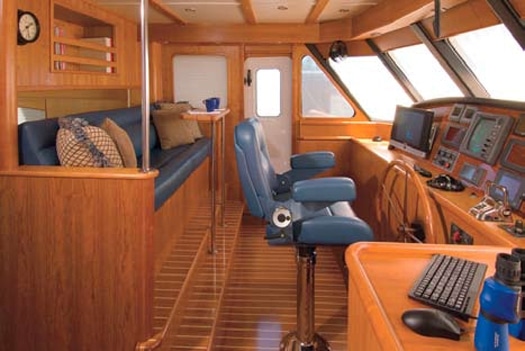
|
The engineroom is all business and shows the influence of Kanter’s commercial work. The owner wanted the extra assurance of being able to reach 20 knots, so he chose a pair of 710-horsepower Caterpillar C12 diesels over the standard 525-horsepower Luggers. There is, however, little room forward of the big Cats, making some maintenance procedures difficult, and in retrospect the owner feels he would have been just as happy with the smaller engines. Hopefully, the smaller engines would also increase the vessel’s range, which is about 830 nautical miles at 10 knots with the Cats.
Our sea trial on the ICW at Great Bridge, Virginia, was too far from the ocean to test the boat’s seakeeping abilities. While Sunshine was prepped for stabilizers, the owner chose not to install them, and he reports that the boat’s hull form is so stable, he doesn’t need them. Sunshine’s fast cruising speed is 18 knots, but most owners would probably run her at 10 knots, where sound levels are quiet and the fuel burn is acceptable.
As we approached the marina on this blustery fall day, I gladly gave the helm back to Manfred, Jr. He deftly used the thrusters to center Sunshine in a slip that had no more than 6 inches of clearance on each side. If by chance he misjudged the nail-biting maneuver, this robustly constructed ship, with its welded aluminum hull and stout rub rails, would have undoubtedly won the argument with the dock. The custom Kanter 56 is a strong, competitive alternative to today’s production yachts.
Kanter Yachts, (619) 633-1058; www.kanteryachts.com





